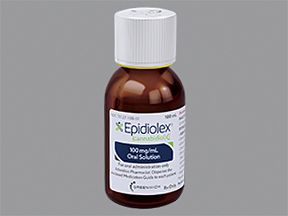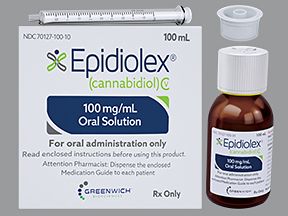The prescribed dosage for Epidiolex (cannabidiol) may depend on a person’s individual treatment plan. Factors like your medical history and body weight may affect your dosage of Epidiolex.
Epidiolex (cannabidiol) is a prescription drug used to treat certain seizure disorders. The drug comes as a liquid solution that you swallow. It’s usually taken twice per day. Epidiolex is used in adults and certain children to treat seizures associated with:
- epilepsy syndromes that begin during infancy and childhood, specifically:
- tuberous sclerosis complex
The active ingredient in Epidiolex is cannabidiol (CBD). Epidiolex belongs to a group of drugs called cannabinoids.
This article describes the dosages of Epidiolex, as well as its strength and how to take it. To learn more about Epidiolex, including its side effects and uses, read this in-depth Epidiolex article.
Your doctor will likely start you on a low dosage and adjust it over time to reach the right amount for you. They’ll ultimately prescribe the smallest dosage that provides the desired effect.
The following table highlights the basics of Epidiolex’s dosage. All doses are listed in milligrams per kilogram of body weight (mg/kg).
Always take the dosage your doctor prescribes for you. They’ll determine the best dosage to fit your needs. In some cases, doctors may adjust your dosage from those shown here.
| Condition | Starting dosage | Maintenance dosage | Maximum dosage |
|---|---|---|---|
| Dravet syndrome | 2.5 mg/kg twice per day | 5 mg/kg twice per day | 10 mg/kg twice per day |
| Lennox-Gastaut syndrome | 2.5 mg/kg twice per day | 5 mg/kg twice per day | 10 mg/kg twice per day |
| tuberous sclerosis complex | 2.5 mg/kg twice per day | 12.5 mg/kg twice per day | — |
Epidiolex form
Epidiolex comes as a liquid solution that you swallow. It can also be given through a feeding tube.
Epidiolex concentration: How much CBD is in Epidiolex?
Epidiolex comes in one concentration: 100 milligrams of CBD per milliliter of solution (mg/mL). It’s available in bottles of 60 mL and 100 mL.
Epidiolex is approved to treat seizures caused by the following conditions:
The prescribed Epidiolex dosage may vary depending on the condition it’s being used to treat. Always follow your doctor’s instructions. Notify them if you experience any side effects that may prevent you from taking your medication.
Dosage for Dravet syndrome and Lennox-Gastaut syndrome
For seizures caused by Dravet and Lennox-Gastaut syndromes, the starting dosage is 2.5 mg/kg twice per day.
After a week, if you tolerate the dosage well, the doctor may increase the dosage to 5 mg/kg twice per day. If needed, the doctor can prescribe a maximum dosage of 10 mg/kg twice per day.
Dosage for tuberous sclerosis complex
For seizures caused by the tumors of tuberous sclerosis complex, the starting dosage is 2.5 mg/kg twice per day.
Every week, your doctor can increase the dosage by 5 mg/kg per day, or 2.5 mg/kg per dose. If the increased dosage of Epidiolex continues to be tolerable with few side effects, your doctor will eventually prescribe the recommended maintenance dosage of 12.5 mg/kg twice per day.
Doctors can prescribe Epidiolex to children ages 1 year and older.
The dosage of Epidiolex for children is the same as the dosage for adults. Your child’s doctor will start them on a dose of 2.5mg/kg twice per day. Then, depending on your child’s condition and how their body responds to treatment, their doctor may increase the dosage weekly.
For Dravet syndrome and Lennox-Gastaut syndrome, the maximum recommended dosage is 10 mg/kg twice per day (20 mg/kg total).
For tuberous sclerosis complex, the maximum recommended dosage is 12.5 mg/kg twice per day (25 mg/kg total).
Epidiolex comes as a liquid solution that you swallow. It can also be given through a feeding tube.
Take it consistently with or without food. This means that if you usually take Epidiolex with a meal, it’s best to always take it with a meal. And if you usually take Epidiolex without food, it’s best to always take it without food.
Each bottle of Epidiolex comes with a syringe with volume markers. To measure the amount of Epidiolex you need, you’ll use the provided syringe to draw up the volume of liquid solution your doctor prescribed.
How long do you take Epidiolex?
Epidiolex is usually a long-term treatment. If you and your doctor determine that it’s safe and effective for your condition, you’ll likely take it long term once you reach your maintenance dose.
Be sure to follow the Epidiolex prescription as written by your doctor. Too much Epidiolex can lead to harmful effects. To learn more, see this article about Epidiolex’s side effects.
What to do in case you take too much Epidiolex
If you think you’ve taken too much Epidiolex, call your doctor right away. You can also call 800-222-1222 to reach America’s Poison Centers or use its online resource. But if there are severe symptoms, immediately call 911 (or your local emergency number) or go to the nearest emergency room.
Below are answers to some commonly asked questions about Epidiolex’s dosage.
Does Epidiolex have a dose calculator?
Yes, Epidiolex has a dosing calculator on the drug manufacturer’s website. The calculator uses body weight and the recommended daily dosage to calculate each dose in milliliters (mL) and milligrams (mg). Using this calculator, your doctor will determine the correct dosage.
If you have more questions about calculating the dosage, talk with your doctor.
Is the dosage of Epidiolex similar to the dosage of CBD oil?
Epidiolex and CBD oil have the same active ingredient, cannabidiol. (An active ingredient is what makes a drug work.)
Although doctors may recommend Epidiolex and CBD oil to treat certain forms of epilepsy, only Epidiolex has FDA approval for this purpose. Because of this, only Epidiolex has FDA-approved dosage recommendations.
The FDA doesn’t regulate CBD oil as a prescription product. Some forms of CBD oil may contain tetrahydrocannabinol (THC). THC is the component in cannabis products that causes psychological effects.
If you’re interested in taking CBD oil for seizures, you should talk with your doctor about choosing an appropriate product and dosage.
To learn more about how Epidiolex and CBD oil dosages compare, talk with your doctor or pharmacist.
Disclaimer: Healthline has made every effort to make certain that all information is factually correct, comprehensive, and up to date. However, this article should not be used as a substitute for the knowledge and expertise of a licensed healthcare professional. You should always consult your doctor or another healthcare professional before taking any medication. The drug information contained herein is subject to change and is not intended to cover all possible uses, directions, precautions, warnings, drug interactions, allergic reactions, or adverse effects. The absence of warnings or other information for a given drug does not indicate that the drug or drug combination is safe, effective, or appropriate for all patients or all specific uses.






